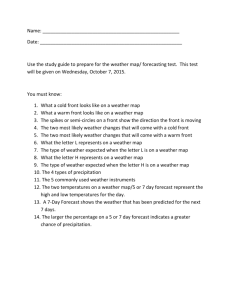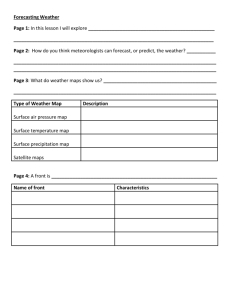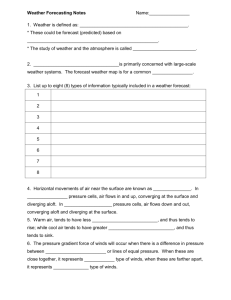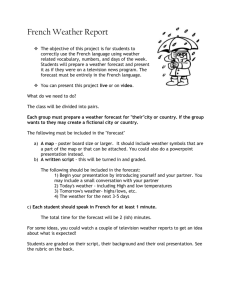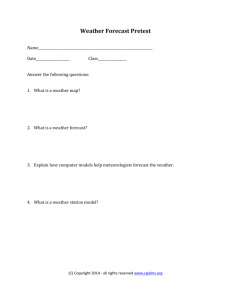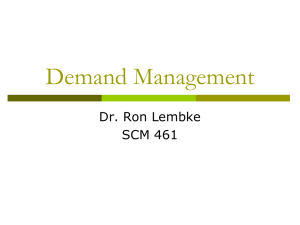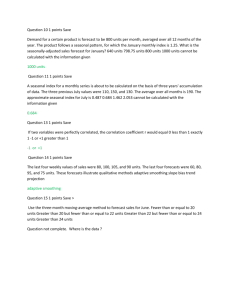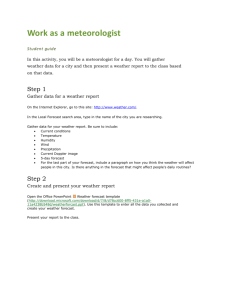Chapter 13
advertisement
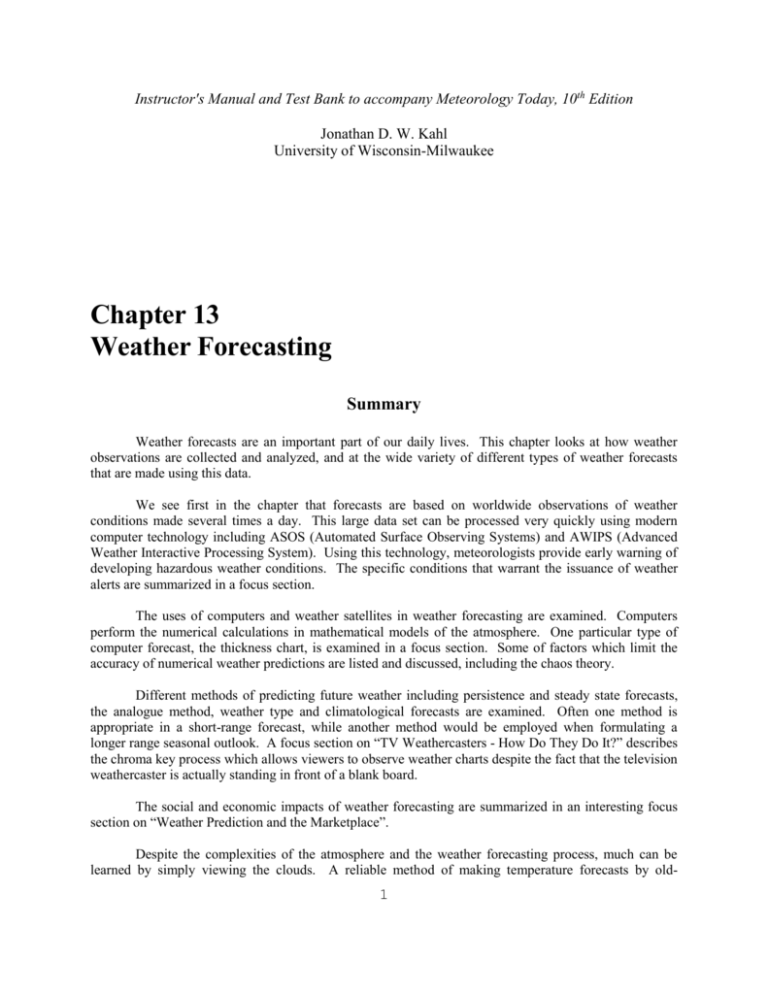
Instructor's Manual and Test Bank to accompany Meteorology Today, 10th Edition Jonathan D. W. Kahl University of Wisconsin-Milwaukee Chapter 13 Weather Forecasting Summary Weather forecasts are an important part of our daily lives. This chapter looks at how weather observations are collected and analyzed, and at the wide variety of different types of weather forecasts that are made using this data. We see first in the chapter that forecasts are based on worldwide observations of weather conditions made several times a day. This large data set can be processed very quickly using modern computer technology including ASOS (Automated Surface Observing Systems) and AWIPS (Advanced Weather Interactive Processing System). Using this technology, meteorologists provide early warning of developing hazardous weather conditions. The specific conditions that warrant the issuance of weather alerts are summarized in a focus section. The uses of computers and weather satellites in weather forecasting are examined. Computers perform the numerical calculations in mathematical models of the atmosphere. One particular type of computer forecast, the thickness chart, is examined in a focus section. Some of factors which limit the accuracy of numerical weather predictions are listed and discussed, including the chaos theory. Different methods of predicting future weather including persistence and steady state forecasts, the analogue method, weather type and climatological forecasts are examined. Often one method is appropriate in a short-range forecast, while another method would be employed when formulating a longer range seasonal outlook. A focus section on “TV Weathercasters - How Do They Do It?” describes the chroma key process which allows viewers to observe weather charts despite the fact that the television weathercaster is actually standing in front of a blank board. The social and economic impacts of weather forecasting are summarized in an interesting focus section on “Weather Prediction and the Marketplace”. Despite the complexities of the atmosphere and the weather forecasting process, much can be learned by simply viewing the clouds. A reliable method of making temperature forecasts by old- 1 2 fashioned cloud watching is described in a focus section entitled “Forecasting Temperature Advection by Watching the Clouds”. A detailed case-study forecast is presented in a section entitled "A Forecast for Six Cities". This section steps the reader through the mechanics of making forecasts for several locations, including consideration of a variety of maps and forecast methods. The chapter concludes with examples of how fairly accurate short term forecasts can be made using data from surface charts and a knowledge of the upper level wind patterns. Students should find these examples particularly instructive as they apply many of the concepts developed in previous chapters. Teaching Suggestions 1. A local broadcast meteorologist may be willing to come and speak to the class. Or, in the case of a small class, it might be possible to arrange a visit to the studio to see a weather broadcast. A small class could also, in some cities, visit the local weather service office. 2. Using the present surface and upper air charts together with prognostic charts, make a 12, 24 and 36 hour forecast in class. Use a variety of forecast methods or let the students decide what type of forecast method they think would be most suitable. If the upper level forecast charts do not show a large change during the forecast period, a persistence forecast might be most appropriate. The steady state method could be used in the case of an approaching storm system or front. Some storms might resemble events from earlier in the semester in which case an analogue type forecast could be made. Define criteria that will allow verification of the various forecasts. 3. Discuss the bases for forecast ‘skill’. Ask students to consider how forecast skill should be defined: Should a skillful forecast be better than a random forecast? Better than climatology? Better than persistence? 4. Students might be interested to know that even during times of war and other conflicts, meteorological measurements is still freely shared among the international community. Websites for the weather agencies for most countries can be found at the World Meteorological Society’s website: http://www.wmo.int/pages/members/index_en.html 5. Discuss the types of weather watches, warnings and advisories that are issued for your area. Ask students if they have been in other areas where other types of alerts have been issued. 6. Design a weather forecasting competition for the class. Students could compete not only against each other, but also against the class average or local television stations or a climatological forecast. A model for such a competition is available here: https://pantherfile.uwm.edu/kahl/www/WebQuests/Showdown/ 7. Examine the effect of lag time on weather forecasts. A visual comparison of forecasts made at different lag times is available here: http://waterbase.glwi.uwm.edu/tvlog/ 3 8. Design a weather forecasting competition that includes the effect of lag time on forecast accuracy. An example of this type of competition is available here: https://pantherfile.uwm.edu/kahl/www/WebQuests/Time/ 9. Ask students what they think phrases like “partly cloudy” and “30% chance of precipitation” mean. You’re likely to get many conflicting answers. It may surprise students to learn that the U.S. National Weather Service has very specific definitions for these terms: http://www.crh.noaa.gov/lmk/?n=generalforecastterminology 10. On a day with clouds at more than one altitude, take the class outside to observe the differential cloud movement at different altitudes. As described in the focus section on Forecasting Temperature Advection by Watching the Clouds, use the students’ observations of cloud movement to forecast temperature changes. Student Projects 1. Provide students with surface and upper level charts and have them predict the future motion of a middle latitude storm system using the methods listed in the text (past motion, upper-level winds, winds in the warm sector, and movement toward the region of maximum pressure decrease). Have the students compare their predicted location with the actual location at the end of the forecast period. Using their predictions of storm positions, students could issue specific forecasts for cities that the storm is likely to affect. This exercise could be patterned after the example in the text. 2. Have students compare the actual year-to-date average weather conditions (mean temperatures and precipitation amounts) with climatological averages for their region. Prepare a climatological forecast for the remainder of the semester or the year. 3. Students might try to forecast first or last frost dates, first snow fall, first day over 100 oF, or some other event using climatological data. They might modify their forecast by noting whether conditions thus far during the year have been above or below the climatological average. Can they account for any departure from average conditions? 4. Have students prepare persistence, steady-state, and climatological forecasts for their local area, and compare them with forecasts made by local television or radio broadcast meteorologists. 5. Have students inspect ensemble forecasts to assess the confidence of a particular forecast. A resource for this is: http://www.esrl.noaa.gov/psd/map/images/ens/ens.html Answers to Questions for Review 1. The National Center for Environmental Prediction (NCEP) receives global weather data from several world meteorological centers many times each day. The data is analyzed and plotted, and forecasts are prepared and transmitted to National Center for Environmental Prediction (NCEP). 2. A watch indicates that atmospheric conditions favor hazardous weather occurring over a 4 particular region during a specified time period. A warning, on the other hand, indicates that hazardous weather is either imminent or actually occurring within the specified forecast area. Advisories are issued to inform the public of less hazardous conditions caused by wind, dust, fog, snow, sleet, or freezing rain. 3. Soundings, satellite imagery, Doppler radar, surface weather maps, upper-air winds, and pattern recognition, computer-drawn progs and statistical information such as Model Output Statistics (MOS). 4. The initial chart in the numerical weather prediction process is referred to as an analysis. The analysis represents current conditions which are used to make a prediction about the future condition of the atmosphere. The final forecast chart representing the atmosphere at a specified future time is called a prognostic chart, or, simply, a prog. 5. Modern electronic computers can analyze large quantities of data extremely fast. Each day the many thousands of observations transmitted to NCEP are fed into a high-speed computer, which plots and draws lines on surface and upper-air charts. Meteorologists interpret the weather patterns and then correct any errors that may be present. The routine daily forecasting of weather by the computer has come to be known as numerical weather prediction. To help forecasters handle all the available charts and maps, high-speed data modeling systems using computers are employed. The communication system in use today is known as AWIPS (Advanced Weather Interactive Processing System). 6. The models are programmed into the computer, and surface and upper-air observations of temperature, pressure, moisture, winds, and air density are fed into the equations. To determine how each of these variables will change, each equation is solved for a small increment of future time, say, five minutes, for a large number of locations called grid points, each situated a given distance apart. In addition, each equation is solved for as many as 50 levels in the atmosphere. The results of these computations are then fed back into the original equations. The computer again solves the equations with the new “data,” thus predicting weather over the following five minutes. This procedure is done repeatedly until it reaches some desired time in the future, usually 12, 24, 36, or 48 hours. The computer then analyzes the data and draws the projected positions of pressure systems with their isobars or contour lines. 7. The sparsity of observations over uninhabited regions of the earth, errors related to weather systems crossing the boundaries of model domains, difficulty in forecasting small-scale weather features, inadequate characterization of interactions of water, ice, surface friction, and local terrain, large sensitivities to initial imperfections (chaos). 9. Persistence: a prediction that future weather will be the same as present weather. If it is snowing today, a persistence forecast would call for snow through tomorrow. Steady-state (trend) method: The principle involved here is that surface weather systems tend to move in the same direction and at approximately the same speed as they have been moving, providing no evidence exists to indicate otherwise. Suppose, for example, that a cold front is moving eastward at an average speed of 30 km per hour and it is 90 km west of your home. Using the steady-state method, we might extrapolate and predict that the front should pass through your area in three hours. Analogue method: this method relies on the fact that existing features on a weather chart (or a series of charts) may strongly resemble features that produced certain weather conditions sometime in the past. A forecaster might look at a prog and say “I’ve seen this weather situation before, and this happened.” Prior weather events can then be utilized as a guide to the future. Statistical methods: known as Model Output Statistics, or MOS, these predictions, in effect, are statistically weighted analogue forecast corrections incorporated into the computer model output. For example, a forecast of tomorrow’s maximum temperature might be derived from a statistical 5 equation that uses a numerical model’s forecast of relative humidity, cloud cover, wind direction, and air temperature. 10. A forecaster might look at a prog and say “I’ve seen this weather situation before, and this happened.” Prior weather events can then be utilized as a guide to the future. The problem here is that, even though weather situations may appear similar, they are never exactly the same. There are always sufficient differences in the variables to make applying this method a challenge. 11. Ensemble forecasting is a technique based on running several forecast models (or different versions of a single model), each beginning with slightly different weather information to reflect errors in the measurements. If the different versions agree fairly well, a forecaster can place a high degree of confidence in the forecast. A low degree of confidence means that the models do not agree. 12. Using information about weather interactions in different regions of the world, the Climate Prediction Center can issue a seasonal outlook of an impending wetter or drier winter, months in advance. Forecasts using teleconnections have shown promise. For example, as the tropical equatorial Pacific became much warmer than normal during the spring and early summer of 1997, forecasters predicted a wet rainfall season over central and southern California. 13. 30 to 50 percent. 14. Forecasts show skill when they are more accurate than a forecast utilizing only persistence or climatology. 15. No. If the precipitation is of a steady nature, the forecast of "20 percent chance" means there is a slight chance of precipitation. If the precipitation is showery, the forecast means widely scattered showers are expected. 16. No. These forecasts, called outlooks, predict average weather conditions for a particular month or a season. These are not forecasts in the strict sense, but rather an overview of how average precipitation and temperature patterns may compare with normal conditions. 17. Warm advection. 18. Patterns of divergence and convergence aloft, computer progs, comma clouds observed from satellite observations, Doppler radar observations of precipitation. 19. An omega high as a blocking high, one that tends to persist in the same geographic location for many days. This blocking pattern also tends to keep the surface highs and lows in their respective positions. 20. Probability forecast. 21. Highs tend to move where the isallobars indicate positive values; lows move where isallobars are negative. 6 Answers to Questions for Thought 1. Answer not provided. 2. Chances are that only one Christmas out of ten will be a white one. If last Christmas turned out to be white, then based on climatology, next Christmas should be non-white. If you forecasted a nonwhite Christmas and this forecast turned out to be correct, then your forecast was accurate but you showed no skill because your forecast was not better than climatology. 3. A persistence forecast would call for warm and rain. We would not expect the forecast to be correct because the weather will change dramatically as the cold front passes. A forecast using the steady state method: "Warm and rain, turning colder with rain changing to snow." 4. A reduction in grid spacing causes a large increase in grid points. For example, in a 100 km x 100 km area, there are 100 grid points if 10 km x 10 km grid spacing is used. If 1 km x 1 km spacing is used, the number of grid points increases to 10,000. Since a set of equations must be solved at each grid point for each model time step, a reduction in grid spacing creates a great challenge for numerical weather prediction computers. 5. The computer models used in weather forecasting are "sensitive" to the data initially fed into them. For example, small unpredictable atmospheric fluctuations (chaos), and small errors in the data usually amplify with time as the computer projects the weather days into the future. These small initial imperfections often dominate after several days, causing the forecast chart to show little resemblance to the behavior of the real atmosphere. 6. Warmer. Current air is from the Canadian Arctic and therefore cold, whereas tomorrow’s air will likely originate over the Pacific Ocean west of the Rockies. Answers to Critical Thinking Questions Figure 13.4. Change to rain. The veering winds indicate increasing temperatures. Figure 13.11. A trough would be expected over the Rocky Mountains. Figure 13.17. A warm front could be drawn based on the temperature gradient between Augusta and Washington; however, a significant shift in wind direction is not present in this region. 7 Multiple Choice Exam Questions 1. A weather warning indicates that a. the atmospheric conditions are favorable for hazardous weather over a particular region. b. hazardous weather is either imminent or occurring within the forecast area. c. hazardous weather is likely to occur within the forecast area during the next 24 hours. d. hazardous weather is frequently observed in a particular region. ANSWER: B 2. A weather watch would probably be issued for which of the following conditions? a. There is a chance for tornadoes tomorrow. b. Presently, extremely high winds are occurring at mountain summits. c. A tornado has been sighted at the outskirts of town. d. Heavy snow has been falling over the forecast area. ANSWER: A 3. An analysis is a. a forecast chart that shows the atmosphere at some future time. b. a forecast chart that compares past weather maps with those of the present. c. a surface or upper-level chart that interprets the present weather patterns. d. a forecast method used in long range weather prediction. e. a method used to determine skill in predicting the weather. ANSWER: C 4. A forecast of an extended period of dry weather would be made for a region beneath a. an upper-level trough. b. the polar jet stream. c. a cold pool of air aloft. d. an upper-level ridge. e. a shortwave trough. ANSWER: D 5. Suppose it is warm and raining, and a cold front is moving toward your location. Directly behind the cold front, it is cold and snowing. Still further behind the front, the weather is cold and clearing. If the front is scheduled to pass your area in 6 hours, a persistence forecast for your area for 12 hours from now would be a. cold and snowing. b. cold and clearing. c. cold and cloudy. d. warm and raining. e. not enough information on which to base a forecast ANSWER: D 8 6. The least accurate forecast method of predicting the weather two days into the future during changeable weather conditions is usually the a. trend method. b. persistence forecast. c. analogue method. d. prediction by weather types. e. numerical weather prediction. ANSWER: B 7. Weather forecast that predicts that the future weather will be the same as the present weather is called a. a steady-state forecast. b. the trend method. c. a persistence forecast. d. the analogue method. e. an extended weather forecast. ANSWER: C 8. Which forecasting method assumes that weather systems will move in the same direction and at the same speed as they have been moving? a. persistence forecast b. probability forecast c. weather type forecast d. climatological forecast e. steady state (trend) forecast ANSWER: E 9. A persistence forecast could be quite accurate when a. a frontal system approaches your location at constant speed. b. you are positioned in the middle of a large, stationary air mass. c. the weather has been unusually cold for several days. d. upper level winds blow straight from west to east. ANSWER: B 10. A weather forecast for the immediate future that employs the trend method is called a. nowcasting. b. extrapolation. c. first order forecast. d. linear forecast. ANSWER: A 11. By examining a surface map, the movement of a surface low pressure area can be predicted based upon the a. orientation of the isobars in the warm sector. 9 b. region of greatest pressure decrease. c. movement during the previous 6 hours. d. all of the above ANSWER: D 12. Predicting the weather by weather types employs which forecasting method? a. probability b. steady-state c. analogue d. persistence e. guess ANSWER: C 13. is A forecast method that compares past weather maps and weather patterns to those of the present a. b. c. d. persistence forecasting. the analogue method. the trend method. nowcasting. ANSWER: B 14. The forecasting technique that produces several versions of a forecast model, each beginning with slightly different weather information to reflect errors in the measurements, is called a. climatology forecasting. b. redundancy analysis. c. persistence forecasting. d. ensemble forecasting. e. probability forecasting. ANSWER: D 15. Suppose that where you live, the middle of January is typically several degrees warmer than the rest of the month. If you forecast this "January thaw" for the middle of next January, you would have made a a. forecast based on the analogue method. b. persistence forecast. c. forecast based on weather types. d. probability forecast. e. climatological forecast. ANSWER: E 16. A probability forecast that calls for a "40 percent chance of rain" means that a. there is a 40 percent chance that it will not rain within the forecast area. b. there is a 40 percent chance that any random place in the forecast area will receive measurable rain. 10 c. it will rain on 40 percent of the forecast area. d. it will rain during 40 percent of the time over the forecast area. ANSWER: B 17. Which of the following is presently a problem with modern-day weather predictions? a. Computer forecast models make assumptions about the atmosphere that are not always correct. b. There are regions of the world where only space observations are available. c. Computer models do not always adequately interpret the surface's influence on the weather. d. The distance between grid points on some models is too large to pick up smaller-scale weather features such as thunderstorms. e. all of the above ANSWER: E 18. An accurate forecast a. always shows skill. b. may or may not show skill. c. never shows skill. d. requires complex computer equipment. ANSWER: B 19. For a forecast to show skill it must a. be better than one based on persistence or climatology. b. be c. be accurate for over more than 90 percent of the forecast area. d. use the analogue method of forecasting. e. use a probability. ANSWER: A 20. A prog is a. a chart that interprets the current state of the atmosphere. b. an instrument that draws lines on an upper-level chart. c. a new method of forecasting the weather. d. a forecast chart that shows the atmosphere at some future time. e. another name for a probability forecast. ANSWER: D 21. The forecasting of weather by a computer is known as a. weather type forecasting. b. climatology forecasting. c. extended weather forecasting. d. analogue prediction. e. numerical weather prediction. 11 ANSWER: E 22. The greatest improvement in forecasting skill during the past 30 years has been made in forecasting a. snowstorms along the eastern seaboard. b. the development of middle latitude cyclones in the Pacific Ocean. c. severe storm warnings for hurricanes and tornadoes. d. the movement of warm and cold fronts. e. maximum and minimum temperature 6 to 10 days into the future. ANSWER: C 23. Automated Surface Observing Systems (ASOS) measure a. wind speed and direction. b. temperature and dew point. c. air pressure. d. all of the above ANSWER: D 24. A wind that changes direction in a counterclockwise sense with increasing height is called a(n) a. backing wind. b. Ekman spiral. c. meridional wind. d. veering wind. ANSWER: A 25. Warm advection is most likely to occur a. in the center of a cut-off low. b. from the surface up to the 500 mb level ahead of an advancing warm front. c. behind a cold front. d. where the winds back with height. e. on the western side of a shortwave trough at the 500 mb level. ANSWER: B 26. The National Weather Service system of watches, warnings, and advisories generally don't address weather conditions which limit visibility. a. true b. false ANSWER: B 27. Suppose there are two cloud layers above you. The lower cloud layer is moving from a westerly direction, while the higher cloud layer is moving from a northwesterly direction. From this observation you conclude that the wind is ____ with height and ____ advection is occurring between the cloud layers. a. backing, cold 12 b. backing, warm c. veering, cold d. veering, warm ANSWER: D 28. When making a forecast, a meteorologist typically examines a. surface charts. b. upper-air charts. c. radar displays. d. satellite imagery. e. all of the above ANSWER: E 29. Modern computer forecasting models have increasingly smaller grid spacing. This presents which of the following problems? a. Mesoscale weather features can be predicted. b. Small-scale weather features can be resolved by the models. c. Many more computations are needed. d. none of the above ANSWER: C 30. Very short-range forecasts often utilize which of the following forecast methods? a. steady-state or trend method b. pattern recognition method c. ensemble method d. both steady-state (trend method) and ensemble method e. both steady-state (trend method) and pattern recognition method ANSWER: E 31. Lines connecting points of equal pressure change are called a. isobars. b. isograds. c. contours. d. isotherms. e. isallobars. ANSWER: E 32. Which below is not a condition associated with an omega high? a. It is in the shape of the Greek letter "omega." b. It is known as a "blocking high." c. It forms when the flow aloft is zonal. d. It tends to persist in the same geographic area for many days. ANSWER: C 13 33. A comma cloud is a. an organized band of clouds that looks like a comma on a satellite photograph. b. a large cumulonimbus cloud whose anvil is in the shape of a comma. c. a high wispy cirrus cloud that takes on the shape of a comma. d. the spiraling arms of a hurricane. e. a band of high cirrus clouds blown by the jet stream. ANSWER: A 34. If you wanted to make a persistence forecast of minimum and maximum temperatures for a particular city, which type of chart would be most helpful? a. surface chart b. meteogram c. 500 mb chart d. adiabatic chart e. Doppler radar display ANSWER: B Exhibit 13-1 Use the following illustration of a middle latitude cyclone. The dashed lines show the positions of the fronts 6 hours ago. 35. Refer to Exhibit 13-1. The storm system will apparently move toward the a. northeast. b. east. c. southeast. d. northwest ANSWER: A 36. Refer to Exhibit 13-1. At which of the 4 positions would you expect to hear the following 12-hour forecast: "Cloudy and cold this morning with snow this afternoon and tonight"? a. 1 b. 2 14 c. 3 d. 4 ANSWER: A 37. Refer to Exhibit 13-1. At which of the 4 positions would you expect to hear the following 12-hour forecast: "Cloudy with possible showers today, turning colder by tonight"? a. 1 b. 2 c. 3 d. 4 ANSWER: C 38. Refer to Exhibit 13-1. At which of the 4 positions would you expect to hear the following 12-hour forecast: "Clearing and colder today with continued rising pressures"? a. 1 b. 2 c. 3 d. 4 ANSWER: D 39. Refer to Exhibit 13-1. At which of the 4 positions would you expect to hear the following 12-hour forecast: "Partly cloudy and continued warm through this afternoon and evening"? a. 1 b. 2 c. 3 d. 4 ANSWER: B 40. Which weather advisory is issued when falling or blowing snow and winds of at least 35 miles per hour restrict visibility to less than 1/4 mile for several hours? a. tornado warning b. hurricane warning c. snow advisory d. blizzard warning ANSWER: D 41. Doppler radar is helpful for measuring precipitation, but not wind. a. true b. false ANSWER: B 42. Thickness charts help forecasters a. identify air masses. 15 b. c. d. e. locate fronts. predict daily maximum and minimum temperatures. predict whether falling precipitation will be rain or snow. all of the above ANSWER: E 43. Which of the following can cause errors in forecasts made by numerical weather prediction models? a. flaws in the computer models b. errors that creep in along model boundaries c. sparseness of meteorological data d. inadequate representation of pertinent meteorological processes e. all of the above ANSWER: E 44. The principle that “surface weather systems tend to move in the same direction and at approximately the same speed as they have been moving” forms the basis of which type of forecasting method? a. persistence forecast b. analogue method c. steady-state forecast d. ensemble forecast ANSWER: C 45. A forecast of “chance of precipitation” means a. the probability of precipitation is between 0 and 20 percent. b. the probability of precipitation is between 30 and 50 percent. c. the probability of precipitation is between 60 and 70 percent. d. the probability of precipitation is greater than 80 percent. e. none of the above ANSWER: B 46. Which of the following is not a forecaster’s rule of thumb? a. For short time intervals, mid-latitude cyclonic storms and fronts tend to move in the same direction and at approximately the same speed as they did during the previous six hours. b. Low pressure areas tend to move in a direction that parallels the isobars in the warm air sector. c. Lows tend to move toward the region of greatest pressure drop. d. Highs tend to move toward the region of greatest pressure drop. ANSWER: D 47. Warm advection occurs when a. the wind veers (changes direction in a clockwise manner) with height. b. the wind backs (changes direction in a counterclockwise manner) with height. 16 c. the isotherms are parallel to the winds. d. the wind veers with height and the isotherms are parallel to the winds. ANSWER: A 48. A long-range forecast is a forecast that extends beyond about a. 8.5 years. b. 8.5 months. c. 8.5 weeks. d. 8.5 days. ANSWER: D 49. ____________ tend to steer the movement of surface pressure systems. a. Cumulus clouds b. Doppler radar c. Winds aloft d. Ensemble forecasts ANSWER: C 50. A blocking high is a. a high pressure system and accompanying ridge that changes location quickly. b. a high pressure system and accompanying ridge that persists in the same location for many days. c. a high pressure system and accompanying ridge that produces torrential rains. ANSWER: B Essay Exam Questions 1. List some of the ways that you can predict the future movement of surface middle latitude storms. 2. Describe four different types of weather forecasting methods and give an example of each. 3. List some of the factors that affect the accuracy of atmospheric models. 4. With all other factors being equal, will a cloudy day have a higher or lower maximum temperature then a clear day? How about the minimum temperature during a cloudy vs. clear night? Explain. 5. Suppose a large anticyclone covered the eastern United States. corresponding 500-mb chart would look like? Why? 6. Describe the data and tools that a meteorologist assembles prior to making a weather forecast. 7. What type of forecast method do you think would be most appropriate for a short range (6 to 12 What do you think the 17 hours), a medium range (24 to 48 hours), a long range (5 to 10 days), or a seasonal (3 month) forecast? 8. About how far apart do you think weather observing stations should be in order to accurately depict a middle latitude storm and to be able to forecast the storm's movement? 9. Why do clouds tend to reduce temperatures during the day but increase temperatures at night? 10. What local signs would you look for to predict the approach of a low pressure center or a weather front? 11. Describe the difference between persistence and steady-state forecasts. 12. Assuming you know last night's minimum temperature, what weather information would you use to predict tonight's minimum temperature? 13. Explain how observed teleconnection patterns can help in the preparation of a seasonal weather forecast. 14. Describe the relationship between dew point and minimum temperatures. 15. What are some of the ways that Doppler radar can be used in weather forecasting?
